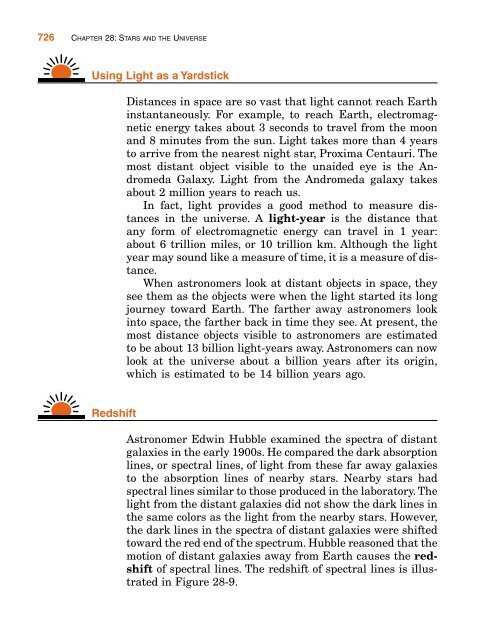Chapter 28 Stars and the Universe
Chapter 28 Stars and the Universe
Chapter 28 Stars and the Universe
You also want an ePaper? Increase the reach of your titles
YUMPU automatically turns print PDFs into web optimized ePapers that Google loves.
726 CHAPTER <strong>28</strong>: STARS AND THE UNIVERSE<br />
Using Light as a Yardstick<br />
Redshift<br />
Distances in space are so vast that light cannot reach Earth<br />
instantaneously. For example, to reach Earth, electromagnetic<br />
energy takes about 3 seconds to travel from <strong>the</strong> moon<br />
<strong>and</strong> 8 minutes from <strong>the</strong> sun. Light takes more than 4 years<br />
to arrive from <strong>the</strong> nearest night star, Proxima Centauri. The<br />
most distant object visible to <strong>the</strong> unaided eye is <strong>the</strong> Andromeda<br />
Galaxy. Light from <strong>the</strong> Andromeda galaxy takes<br />
about 2 million years to reach us.<br />
In fact, light provides a good method to measure distances<br />
in <strong>the</strong> universe. A light-year is <strong>the</strong> distance that<br />
any form of electromagnetic energy can travel in 1 year:<br />
about 6 trillion miles, or 10 trillion km. Although <strong>the</strong> light<br />
year may sound like a measure of time, it is a measure of distance.<br />
When astronomers look at distant objects in space, <strong>the</strong>y<br />
see <strong>the</strong>m as <strong>the</strong> objects were when <strong>the</strong> light started its long<br />
journey toward Earth. The far<strong>the</strong>r away astronomers look<br />
into space, <strong>the</strong> far<strong>the</strong>r back in time <strong>the</strong>y see. At present, <strong>the</strong><br />
most distance objects visible to astronomers are estimated<br />
to be about 13 billion light-years away. Astronomers can now<br />
look at <strong>the</strong> universe about a billion years after its origin,<br />
which is estimated to be 14 billion years ago.<br />
Astronomer Edwin Hubble examined <strong>the</strong> spectra of distant<br />
galaxies in <strong>the</strong> early 1900s. He compared <strong>the</strong> dark absorption<br />
lines, or spectral lines, of light from <strong>the</strong>se far away galaxies<br />
to <strong>the</strong> absorption lines of nearby stars. Nearby stars had<br />
spectral lines similar to those produced in <strong>the</strong> laboratory. The<br />
light from <strong>the</strong> distant galaxies did not show <strong>the</strong> dark lines in<br />
<strong>the</strong> same colors as <strong>the</strong> light from <strong>the</strong> nearby stars. However,<br />
<strong>the</strong> dark lines in <strong>the</strong> spectra of distant galaxies were shifted<br />
toward <strong>the</strong> red end of <strong>the</strong> spectrum. Hubble reasoned that <strong>the</strong><br />
motion of distant galaxies away from Earth causes <strong>the</strong> redshift<br />
of spectral lines. The redshift of spectral lines is illustrated<br />
in Figure <strong>28</strong>-9.

















